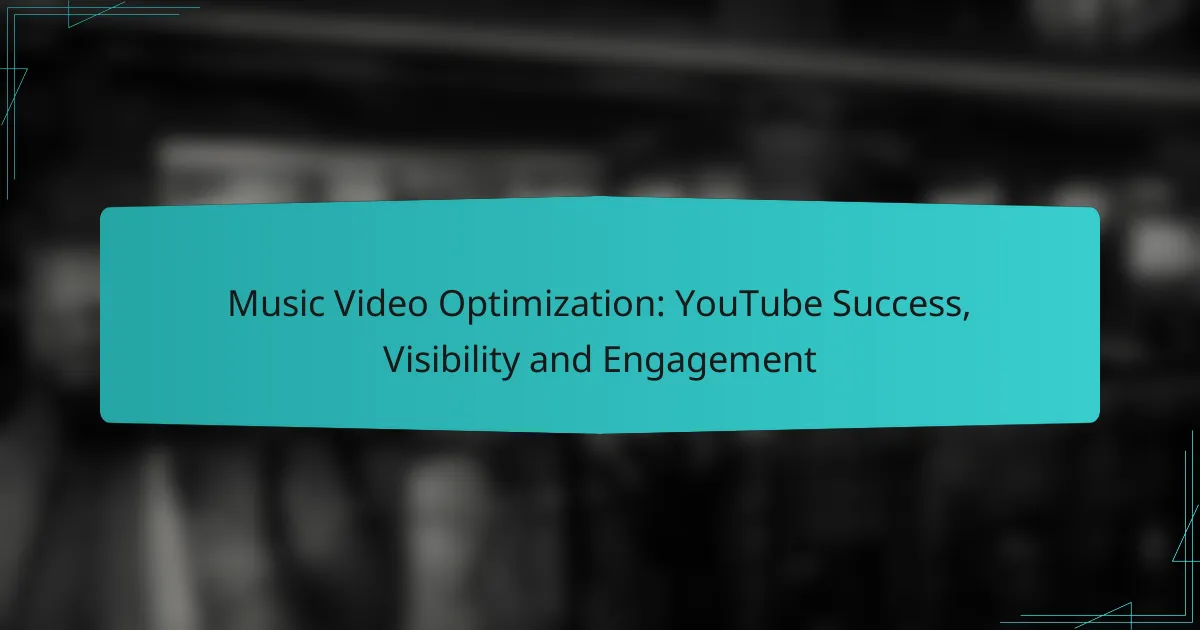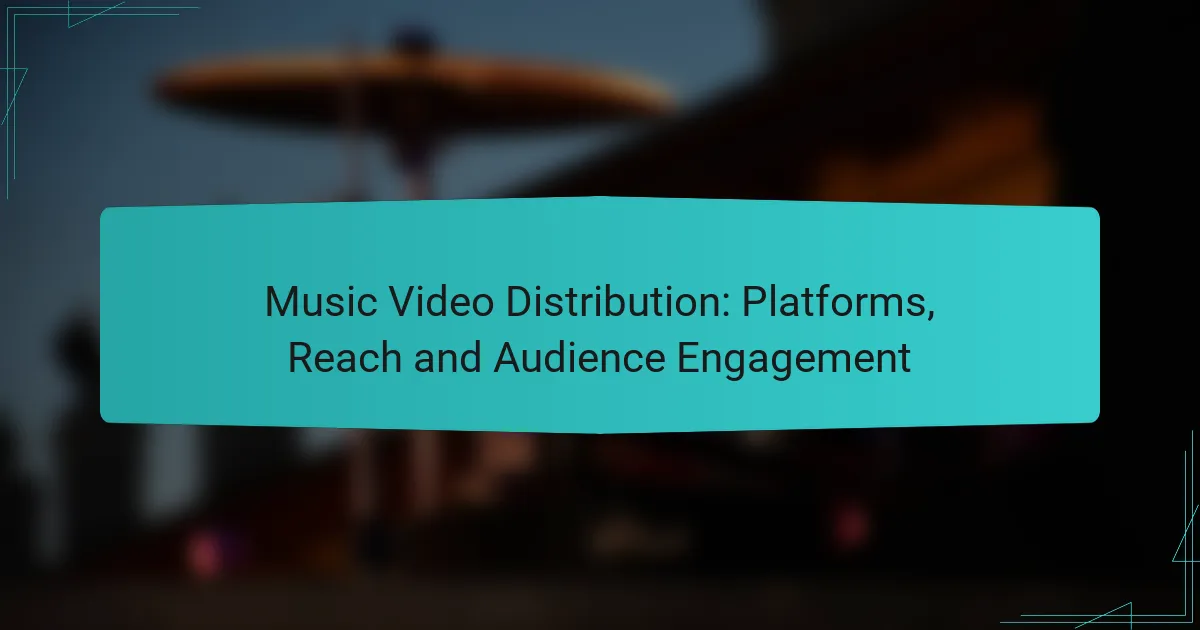Optimizing music videos for YouTube is essential for enhancing visibility and engagement. By utilizing targeted keywords, engaging thumbnails, and effective descriptions, creators can significantly improve their video’s searchability and viewer interaction. Additionally, leveraging analytics allows for informed decisions that can further boost performance and audience retention.
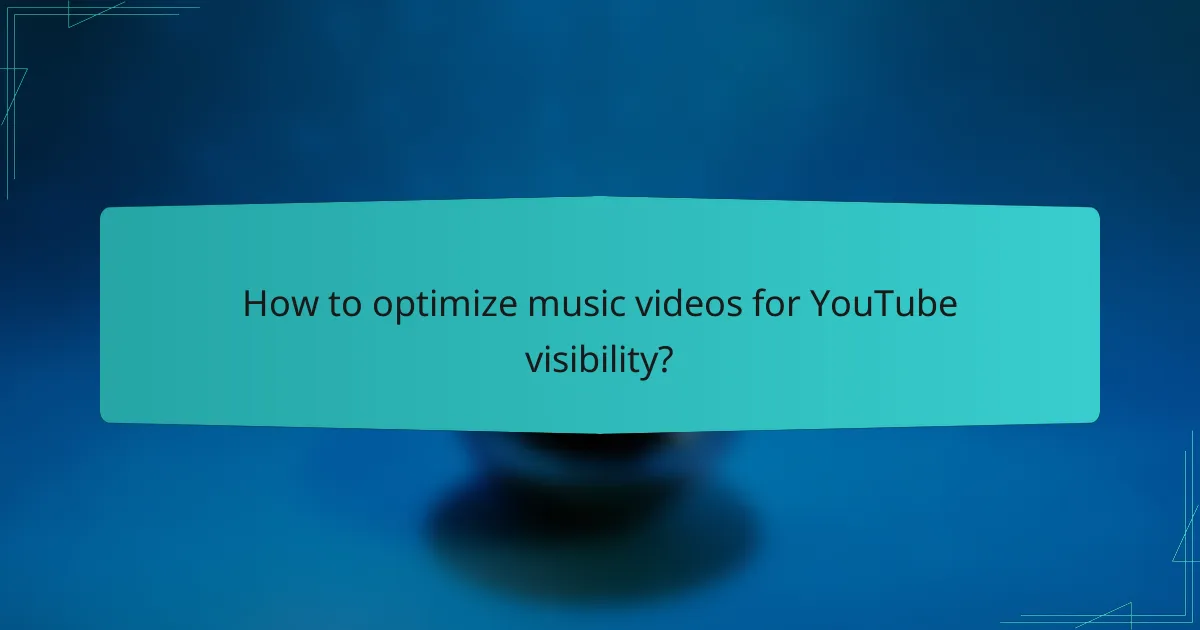
How to optimize music videos for YouTube visibility?
To optimize music videos for YouTube visibility, focus on using targeted keywords, engaging thumbnails, effective descriptions, strategic tags, and organized playlists. These elements enhance searchability and viewer engagement, ultimately increasing your video’s reach and performance.
Use targeted keywords in titles
Incorporating targeted keywords in your video titles is crucial for improving visibility on YouTube. Use specific phrases that potential viewers are likely to search for, such as the song title, artist name, and genre. Aim for titles that are clear and concise, ideally under 60 characters to ensure they display fully in search results.
For example, instead of a generic title like “New Music Video,” use “Artist Name – Song Title (Official Music Video).” This approach helps your video appear in relevant searches and attracts the right audience.
Create engaging thumbnails
An eye-catching thumbnail can significantly impact your video’s click-through rate. Design thumbnails that are visually appealing and relevant to the content, using bright colors and clear imagery. Thumbnails should ideally include text that highlights the song or artist, making it instantly recognizable.
Consider using a consistent style across your thumbnails to build brand recognition. Tools like Canva or Adobe Spark can help you create professional-looking thumbnails quickly.
Utilize video descriptions effectively
Video descriptions are an opportunity to provide context and additional information about your music video. Start with a strong opening line that includes your main keywords, followed by a brief summary of the song and its themes. Include links to your social media, website, and other related content to encourage viewer interaction.
A well-structured description can be around 200-300 words long, providing enough detail without overwhelming viewers. Use bullet points for key information, making it easy to read.
Incorporate tags strategically
Tags help categorize your video and improve its discoverability on YouTube. Use a mix of broad and specific tags related to your music video, including genre, mood, and relevant themes. Aim for about 5-10 tags to avoid overwhelming the algorithm.
For instance, if your video is a pop song, you might use tags like “Pop Music,” “Artist Name,” and “Song Title.” This strategy helps YouTube understand your content and suggest it to viewers interested in similar videos.
Leverage playlists for organization
Creating playlists can enhance user experience and increase watch time on your channel. Organize your music videos into themed playlists, such as “Latest Releases” or “Top Hits,” making it easier for viewers to find and enjoy your content. Playlists can also encourage binge-watching, as viewers are more likely to continue watching if they see a series of related videos.
Consider promoting your playlists on social media and in video descriptions to drive traffic. Regularly update playlists to keep them fresh and engaging for your audience.
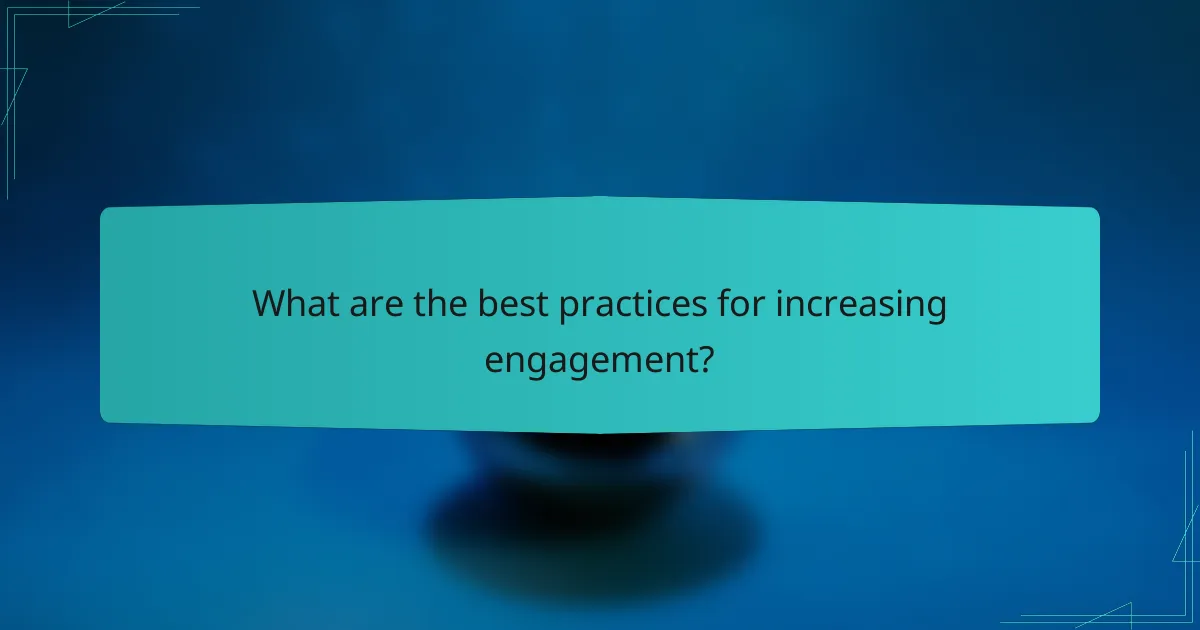
What are the best practices for increasing engagement?
To increase engagement on your music videos, focus on fostering interaction, utilizing platform features, and maintaining communication with your audience. Implementing these strategies can significantly enhance viewer participation and retention.
Encourage viewer interaction
Encouraging viewer interaction is essential for boosting engagement. Ask your audience questions or prompt them to share their thoughts in the comments section. Phrases like “What do you think of this song?” or “Share your favorite lyric!” can stimulate responses.
Consider creating polls or challenges related to your music video. For example, you might ask viewers to post their own dance interpretations or cover versions, which can lead to increased visibility and community involvement.
Utilize end screens and cards
End screens and cards are effective tools for keeping viewers engaged after the video ends. Use end screens to promote other videos, playlists, or your channel subscription. This can lead to longer viewing sessions and increased overall engagement.
Cards can be strategically placed throughout the video to direct viewers to related content or to encourage actions like visiting your website or following you on social media. Ensure these elements are visually appealing and relevant to the content being viewed.
Respond to comments promptly
Responding to comments promptly shows your audience that you value their input and fosters a sense of community. Aim to reply to comments within a few hours to maintain momentum and encourage further discussion.
Consider highlighting insightful or positive comments in your responses, which can motivate others to engage more. Acknowledging feedback, whether positive or constructive, can enhance viewer loyalty and encourage more interaction in the future.

How can analytics improve music video performance?
Analytics can significantly enhance music video performance by providing insights into viewer behavior and engagement. By understanding how audiences interact with your content, you can make informed decisions to optimize visibility and retention.
Track viewer retention rates
Viewer retention rates indicate how well your music video keeps the audience engaged throughout its duration. High retention rates suggest that viewers find the content compelling, while low rates may signal a need for improvement. Aim for retention rates above 50% for optimal performance.
To track retention, use YouTube Analytics to view the audience retention graph. This tool allows you to identify specific moments where viewers drop off, helping you refine future videos to maintain interest.
Analyze traffic sources
Understanding traffic sources reveals where your viewers are coming from, which can guide your promotional strategies. Common traffic sources include YouTube search, suggested videos, external websites, and social media platforms. Focus on optimizing these channels to boost visibility.
Utilize YouTube Analytics to break down traffic sources and assess which ones drive the most views. If a particular social media platform is effective, consider increasing your promotional efforts there to capitalize on that success.
Monitor audience demographics
Audience demographics provide crucial information about the age, gender, and location of your viewers. This data helps tailor your content to better suit your target audience. For example, if a significant portion of your viewers is aged 18-24, consider incorporating trends that resonate with that age group.
Regularly check the demographics section in YouTube Analytics to adjust your marketing strategies and content creation. Understanding your audience can lead to more effective engagement and higher overall performance of your music videos.
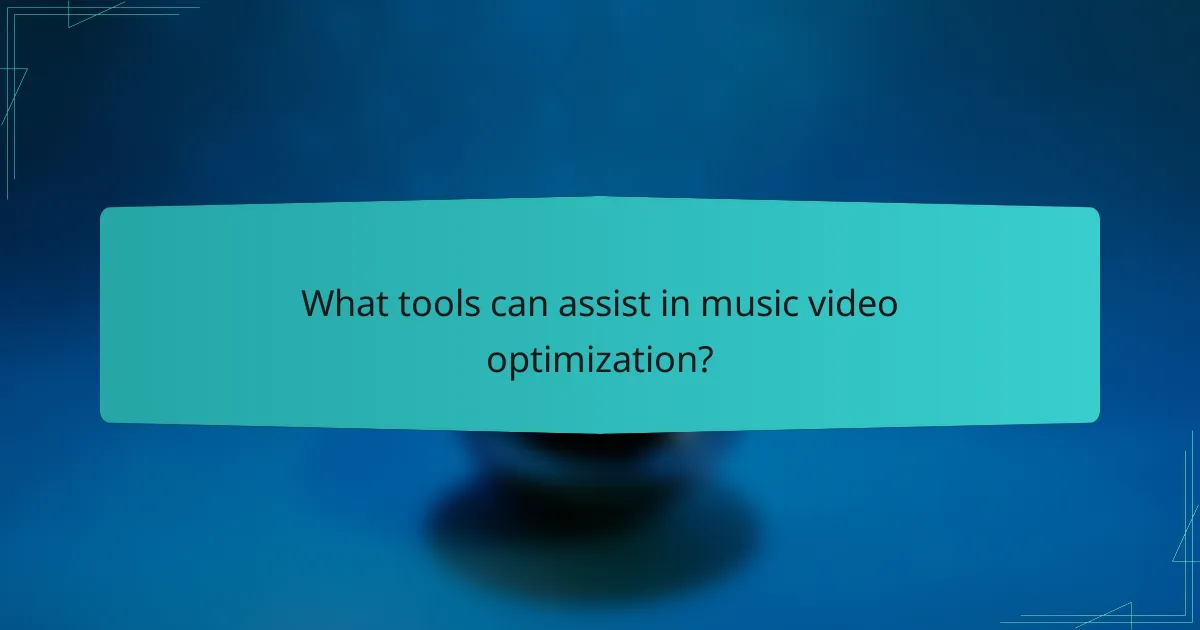
What tools can assist in music video optimization?
Several tools can significantly enhance music video optimization on platforms like YouTube, improving visibility and engagement. Utilizing keyword research, performance tracking, and eye-catching thumbnail design can lead to better audience reach and retention.
TubeBuddy for keyword research
TubeBuddy is a browser extension that helps creators identify effective keywords for their music videos. By analyzing search volume and competition, it allows you to select terms that can improve your video’s discoverability.
When using TubeBuddy, focus on long-tail keywords that are specific to your music genre or style. For example, instead of just “pop music,” consider “upbeat pop music for summer playlists.” This specificity can attract a more targeted audience.
VidIQ for performance tracking
VidIQ is a powerful tool for tracking the performance of your music videos over time. It provides insights into metrics such as views, watch time, and audience engagement, helping you understand what resonates with your viewers.
Utilize VidIQ’s analytics to compare your videos against competitors. Look for trends in successful videos within your genre and adjust your strategy accordingly. Regularly reviewing these metrics can guide future content creation and optimization efforts.
Canva for thumbnail design
Canva is an accessible graphic design tool that allows you to create visually appealing thumbnails for your music videos. A well-designed thumbnail can significantly impact click-through rates and overall engagement.
When designing thumbnails, use bold colors and clear text to convey the essence of your video. Incorporate elements like your artist name or song title prominently. Aim for a resolution of at least 1280 x 720 pixels to ensure clarity across devices.
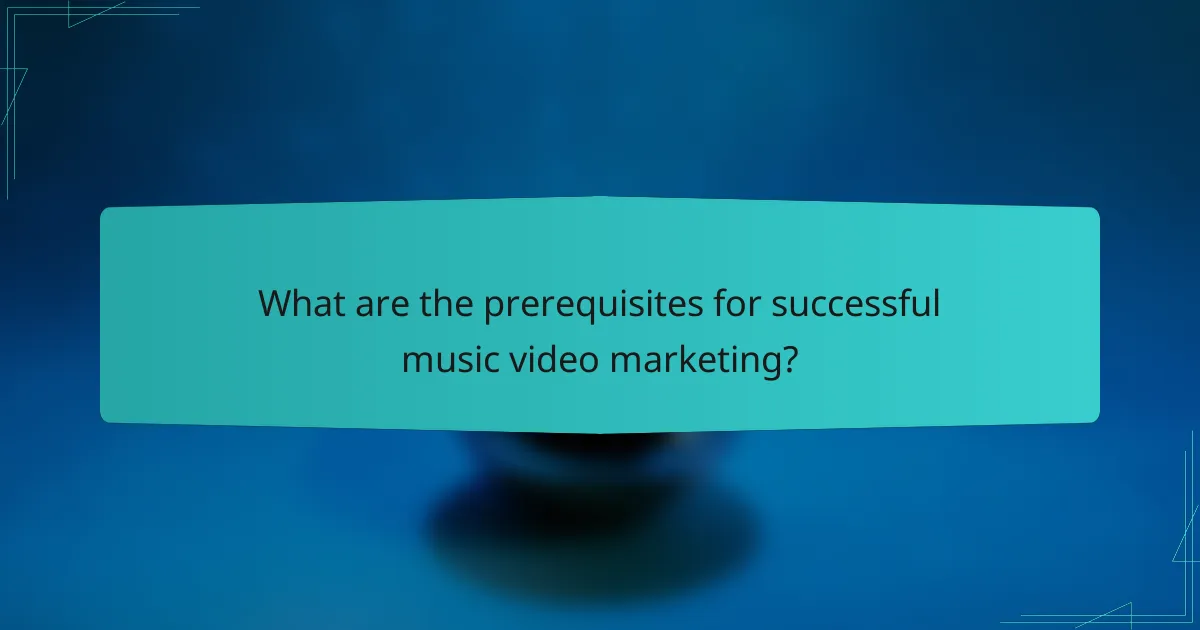
What are the prerequisites for successful music video marketing?
Successful music video marketing requires a clear understanding of your target audience and a consistent brand identity. These elements are crucial for creating engaging content that resonates with viewers and drives visibility on platforms like YouTube.
Understanding target audience
Identifying your target audience is essential for effective music video marketing. Consider demographics such as age, gender, location, and musical preferences to tailor your content accordingly. For instance, a pop artist may focus on younger audiences, while a jazz musician might target older listeners.
Utilize analytics tools to gather insights about your audience’s viewing habits and preferences. This data can guide your content creation, ensuring it aligns with what your audience enjoys. Engaging with fans through social media can also provide valuable feedback and foster a sense of community.
Establishing a consistent brand identity
A strong and consistent brand identity helps your music videos stand out and fosters viewer loyalty. This includes visual elements like logos, color schemes, and video styles that reflect your music’s genre and message. For example, an artist known for vibrant, energetic performances should maintain that aesthetic across all videos.
Consistency extends beyond visuals to include your messaging and tone. Ensure that your social media posts, video descriptions, and interactions with fans convey a unified brand voice. This coherence builds recognition and trust, making viewers more likely to engage with your content and share it with others.
